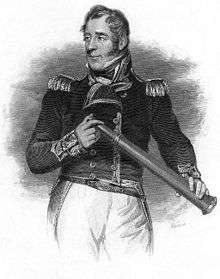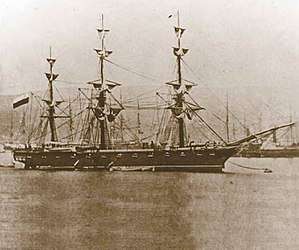Capture of the frigate Esmeralda
The capture of the frigate Esmeralda was a naval action waged on the night of 5 and 6 November 1820. A division of boats with sailors and marines of the First Chilean Navy Squadron, commanded by Thomas Cochrane, stealthily advanced towards Callao and captured the ship through a boarding attack.[Note 1] Esmeralda was the flagship of Spanish fleet and the main objective of the operation.[1] She was protected by a strong military defense that the royalists had organized in the port.
| Capture of the frigate Esmeralda | |||||||
|---|---|---|---|---|---|---|---|
| Part of Peruvian War of Independence | |||||||
.jpg) Capture of the frigate Esmeralda in the bay of Callao, L, Colet, Club Naval, Valparaíso. | |||||||
| |||||||
| Belligerents | |||||||
|
|
| ||||||
| Commanders and leaders | |||||||
| Thomas Cochrane (WIA) |
Antonio Vacaro Juan Francisco Sánchez Luis Coig | ||||||
| Strength | |||||||
|
240 sailors & marines 14 boats |
1 frigate 2 brigs 1 pailebot 14-24 gunboats some armed merchants several harbour batteries | ||||||
| Casualties and losses | |||||||
|
11 killed 22 wounded |
1 frigate captured 3 gunboats captured | ||||||
Both Chilean[2] and Spanish[3] historiography considers that as a result of this naval action the importance or maritime influence of the Spanish Navy in the Pacific disappeared completely. British historians Brian Vale[4] and David J. Cubitt[5] follow the same line of opinion when affirming that Spain had unquestionably lost control of the sea before the Chilean Navy.
Background
On 20 August 1820, the Liberating Expedition commanded by General José de San Martín sailed from Valparaíso to Peru. This force was escorted by the Chilean fleet,[Note 2] under the command of Vice Admiral Cochrane.
Since the beginning of the campaign, San Martín and Cochrane had differences regarding the military strategy that they should carry out in Peru.[7] The first wanted to avoid direct fighting, win over the population and press with indirect actions to Lima. The second wanted to give a decisive blow to the royalists, thus satisfying the need to fight that had the army and the navy. Finally, the thought of San Martín prevailed.
The expeditionary force arrived on 7 September in Paracas, near Pisco.[8] San Martin established his headquarters to put pressure on the royalists.[7] The Viceroy Juaquin de la Pezuela entered into negotiations with San Martin, based on the new peninsular political situation with the proclamation of the Spanish Constitution of 1812.[7] However, the negotiations that took place between the end of September and the beginning of October did not prosper.[9]
At the beginning of October, San Martin sent a division of the army to the Peruvian highlands to revolutionize the territory, giving the command of this force to General Juan Antonio Álvarez de Arenales.
On 9 October 1820, the garrison of Guayaquil mutinied and proclaimed the independence of the city. This fact had material and moral consequences in favor of the revolutionary cause in Peru.[10]
On 26 October, the expeditionary force left Pisco to the north, arriving on the 29th in front of the Callao.[11] The next day, San Martin went to Ancón with the purpose of executing military operations on land.[12] For his part, Cochrane occupied the island of San Lorenzo[13] and stayed at the port exit to establish a rigorous blockade with several ships.[12]
Blockade of Callao
Inactivity of the Spanish Navy

Since the arrival in September of the liberating expedition to the Peruvian coast, the Spanish Navy had not carried out any action of medium efficiency to reject or at least harass the revolutionaries, granting them an expeditious control of the sea.[14][15] This was due to the invariable defensive policy of the Viceroy Pezuela and the incompetence of the Commanding General of Navy Antonio Vacaro.[15][16]
The Spanish fleet, based in Callao, was mainly formed by the frigates Prueba, Venganza and Esmeralda, and also had several other militarily armed ships.[10] The first two frigates, commanded by Captain José Villegas, left the port on 10 October to the Peruvian south with the sole purpose of embarking troops,[17] leaving the third frigate and the other ships under the impressive defense of the port that consisted of a floating palisade that housed them inside, gunboats and batteries.[15][18] Vacaro made this third naval unit the flagship of the squadron under his command.[1]
This was the situation of the Spanish fleet at the time when Cochrane had established the blockade of Callao on 30 October, having at his disposal the frigates O'Higgins and Lautaro, and the corvette Independencia.[19]
The Cochrane plan
The blockade was maintained without difficulty by the Chilean fleet, since the Spanish fleet remained totally on the defensive. However, this situation of total inactivity bothered Cochrane due to its adventurous nature, which led him to the need to undertake some naval action.[19]
To break the monotony of the blockade, he planned to inflict a great blow on the realists in their strong defenses, similar to the capture of the defensive system of Valdivia.[19] On the basis of his own information and that of a subordinate,[20] he decided to undertake a surprise blow that consisted essentially of entering the port at night with several boats and seizing the Esmeralda by means of a boarding attack.[21][22] As a complement to his bold and ambitious plan, he intended to capture or burn the other ships.[22][23][24]
Cochrane began in those days the preparations for the attack that he personally decided to direct, with his usual skill and attention to detail. He selected the officers and men who would participate.[25][26] For three days, the crew was trained to row silently and climb the sides of the ships, without informing them of their plan.[27] On 1 November he had given instructions for the attack to his immediate subordinates.[28] On the night of 4 November, when he had already chosen all the personnel that would accompany him in the attack, he practiced a reconnaissance in the bay, which in turn was an essay of the operation that he had decided to execute in twenty-four hours later.[25]
At dawn on 5 November, final preparations were made for the attack and a speech by Cochrane was read to motivate the crew.[27]
Opposing forces

Chilean Navy
Cochrane gathered 240 men for the attack, of which 160 were chosen sailors and 80 were marines.[25] It occupied 92 men of O'Higgins, 99 of Lautaro and 49 of Independencia.[27]
Regarding the nationality of the crew belonging to the navy that was chosen for the attack, Chilean historian Lopez Urrutia, and also Cubitt, give some figures:[Note 3]
| Name of the ship | Number of men | Chileans | Foreigners |
|---|---|---|---|
| O'Higgins | 92 | ? | ? |
| Lautaro | 99 | 43 relative | 56 relative |
| Independecia | 49 | 15 | 34 |
| Total crew | 240 | ? | ? |
| Total of officers | 32 | 5 | 27 |
They embarked on 14 boats[25] with oars and they were divided into two groups:[24][27]
- The first group, formed by seven boats of O'Higgins, commanded by Captain Thomas Crosbie.
- The second group, formed by the same number of boats from Lautaro and Independencia, commanded by Captain Martin Guise.
Cochrane joined the first group to direct the attack,[27] leaving Captain Robert Foster in charge of all the ships in his absence.[19]
For the attack, they were armed with pistols, but also with boarding axes, daggers or machetes, and short pikes that would be essential for success.[22] His clothes would be a white jacket with a blue ribbon on his arm to recognize himself during the night.[22] If the clothes were not visible in the dark, the words "Gloria" and "Victoria" would be used as a signal.[31]
The oars of the boats were wrapped in canvas to not produce the slightest noise when moving in the water.[22]
Spanish Navy and defense of the port
The Spanish Navy stationed in Callao, under the command of Vacaro, consisted:[18][32]
On the frigate, in addition to the sailors, were on board some troops of the Real Carlos battalion and army gunners.[34] There was a crew of 313 between officers and men.[33]
- Brig Maipú (16[35] guns), under the command of Lieutenant Antonio Madroño.[36]
- Brig Pezuela (20[37] guns), under the command of Lieutenant Ramón Bañuelos.[37]
- Pailebot Aránzazu (11[38] guns), commanded by his private pilot Juan Agustín de Ibarra.[38]
There were also 14[39] to 24[20] gunboats and an undetermined number of armed merchant ships.[14][20][32]
In addition to the naval squadron, there was the artillery of the fortresses and batteries of the port in charge of Brigadier Juan Francisco Sánchez,[25] which consisted:[39]
- Fortresses of Real Felipe, San Rafael and San Miguel.
- Batteries of the Arsenal and San Juaquín.
The defensive formation of the realists consisted of a floating trench formed by trunks attached to chains, which protected the roadstead of the ships and left only a small opening for the entry or exit of them.[32] This floating chain was guarded by the gunboats, and behind this chain were anchored Esmeralda, Maipú (these two at the northern end of the roadstead) Pezuela and Aránzazu, forming these ships the head of the line.[18] In his rear were the armed merchant ships.[32] All this defensive disposition of the squadron was also protected by the batteries of the port.[39] It was an imposing defensive disposition.[39]
Battle
On the afternoon of 5 November, Cochrane ordered Lautaro and Independencia to leave for the high seas, leaving O'Higgins near the island of San Lorenzo, and on one of its hidden side, the boats with their crew destined to attack.[22] With this movement he succeeded in deceiving the royalists, making the surveillance of the port drowsy.[22]
At 10 o'clock at night, the boats separated from O'Higgins, initiating the approach movement towards the entrance of the floating chain that protected the Spanish ships.[40] The boats advanced in two parallel columns according to the groups that formed Crosbie and Guise.[22]
The Chilean force sailed to reach the coast, towards the height of the battery of San Juaquín, which defended the northern end of the port, and then went between the San Miguel fortress and the anchorage of neutral ships to hide its advance.[32] The neutrals were very close to the opening of the floating chain.[32] When passing through that place, they found the frigates USS Macedonian and HMS Hyperion,[40] which were the closest to the entrance of the realistic defense.[32] The North American, upon seeing them, wished them good luck in the attack, while the British, very imprudent, demanded the "who lives" of all the Chilean boats, which fortunately were not heard by the royalists in the port.[40] All this silent movement carried out until now to approach the roadstead had lasted two hours.[41]
At midnight, the boats arrived at the entrance of the floating chain and saw a gunboat guarding the place, with a lieutenant and 14 men on board, so they approached stealthily and surprised her, managing to capture her with the crew and prevent give the alert.[29][40] Once this obstacle was overcome, they entered the interior of the chain, and at approximately 12:30 a.m. on 6 November, they docked at Esmeralda and boarded it from different sides simultaneously.[29] Crosbie's column, at whose head was Cochrane, attacked quickly to starboard, while Guise's column to port.[41] At that time, Coig was in the camera talking to some officers and the crew was sleeping, many of them on the deck.[26][41] Only the guards were alert to any eventuality.[Note 4]
The sleepy crew, newly aware of the surprise attack, went to take up arms to counter attack, but as Cochrane later stated: "the Chilean machetes did not give them much time to organize and recover their spirit".[43] But in spite of the surprise, they gave some resistance in the places that were attacked, giving rise to a bloody fight with sharp weapons and firearms. However, the impetus of the Chilean attack was irresistible and soon occupied some sectors such as the quarterdeck, the frigate's quarters and the stern.[44]
The royalists were pushed to the forecastle, and there they withstood the attack bravely until the forces of Crosbie and Guise united and charged resolutely upon the position.[45] Some of the attackers, who, according to the instructions, had occupied the ladders and climbed to the top in the first moments of the boarding, contributed with the victory by his shots from the height.[43] Having occupied the bow, Guise cleaned the lower deck of the troops that were firing upwards through the hatches.[45] Shortly before 1 a.m. the attackers were in possession of the ship,[46] with the realistic crew that survived surrendered.[45] During the fight, Cochrane received a blow at the beginning and in the final stage a shot that pierced his thigh, which is why he had to sit on the deck and try to direct the attack as best he could.[47]

The fight in Esmeralda alerted the batteries, gunboats and other ships in the port during the night.[48] Also the presence of some fugitives of the frigate who threw themselves into the sea to escape and reported that she had been captured.[48]
When the fight ended in Esmeralda, Cochrane tried to put into practice the complement of his plan, but without success.[Note 5] This was due to the fact that several members of the crew, in the midst of the joy of victory, began to loot the ship and got drunk with the alcohol they found.[49] Indeed, when some officers urged them to embark on the boats to continue the attack against the other Spanish ships, they flatly refused, saying that they had done enough.[45] The few sailors that the officers managed to embark[50] attacked Maipú and Pezuela, but were rejected because these ships were already prepared and had the support of several gunboats directed by the same Vacaro, who was patrolling the bay at the time of the attack. However, the Spanish boss could not do anything to recover his flagship.[51]

Finally, Cochrane ordered Guise to take Esmeralda out of the bay, beginning to move outward along with all the boats and two captured gunboats; the one that observed at the entrance of the floating chain and another that had approached the frigate during the climax of the fight.[51] The batteries, observing that and understanding the situation, began to discharge all their artillery fire to prevent its removal.[52] The ships and gunboats also attacked her. Several shots hit him, one entered through one of the stern windows and damaged the quarterdeck, which caused the death of some men and wounded Coig, who was imprisoned there since the attackers took that sector during boarding.[52]
In these circumstances, the neutral ships USS Macedonian and HMS Hyperion began to move away from the bay to get out of reach of the batteries due to the danger of the shots.[51] At the same time, they placed certain lamps in their rigging that were the signals agreed with the port authorities so that, in case of confrontations, they were not attacked.[52] Cochrane realized this and, understanding its meaning, ordered to place identical lamps in Esmeralda's rigging.[52] This fact caused confusion in the batteries that could not determine which of the three ships with lights was the captured frigate, showing reticence to direct their shots to the foreign ships, so that at approximately 1:15 a.m. they began to decrease.[53]
Esmeralda followed the path to leave the port and around 2:30 a.m. anchored out of range of batteries near O'Higgins.[54] With it came all the smaller boats, towing the two captured gunboats. A little known fact referred by an eyewitness of the attacking forces affirms that one of the boats that belonged to O'Higgins had gone astray, and that during the rest of the night the batteries continued to open fire, without understanding the reason.[55] The doubts disappeared when the sun appeared and the missing boat was seen leaving the port, towing a large gunboat that had captured, so he quickly received help from his comrades to leave the place.[55]
Aftermath
Analysis
Chilean naval researcher Jorge Ureta Muñoz affirms that the main factors that contributed to the successful capture of the frigate are due to the coordination of the details, the general idea of a proven plan, the efficient and energetic driving represented by Cochrane itself and the value of its participants.[31] It also highlights the great importance that the realization of a naval action of this type can have, in the sense that with proportionately smaller means an extraordinary advantage can be obtained by dislocating material or mentally to the adversary, at a minimum cost.[56]
The Spanish historian Fernández Duro compares this naval action with the capture of the Hermione, in Puerto Cabello, in 1799, but affirming that he surpasses it in daring.[36]
According to Spanish historiography, the attack was verified during a ceasefire.[57]
Effects

Legacy
In 1855, by means of a supreme decree issued on 26 June, the Chilean government gave the name of Esmeralda to a corvette that had been built in the United Kingdom for the Chilean Navy. That name was given to him in memory of the frigate that was captured in this naval action.[58] Also the signal "Gloria" and "Victoria", used by Cochrane during the boarding attack, was awarded to the corvette as its motto.[58] This corvette perpetuated the name of Esmeralda in the future ships of the navy, due to his reckless performance in the battle of Iquique on 21 May 1879, during the development of the Pacific War. Currently, the sixth vessel that bears the name is the Esmeralda (BE-43).
The Chilean historian Barros Arana indicated in his book written in 1894 that this naval action has been the battle of the Spanish American wars of independence that has been narrated in a greater number of times in diverse historiographies works.[59]
Notes
- In naval terms, this naval tactic is called a "cutting out operation".
- The squadron was formed by the frigate O'Higgins (flagship), ship of the line San Martín, frigate Lautaro, corvette Independencia, the brigs Galvarino, Pueyrredón and Araucano, and schooner Moctezuma.[6]
- With respect to the 27 foreign officers, Cubitt indicates that they were all British or North American,[29] and López Urrutia simply understands that they were all foreigners.[27] Of the 5 remaining officers, Cubitt is silent,[29] but López Urrutia clarifies that they were Chilean.[27] With respect to the foreign crew, neither Lopez Urrutia[27] nor Cubitt (except the officers)[29] specifies the nationality of the crew, although it is very probable that most of them are British or North American or that all have been of those nationalities. This could be due to the fact that both components were among the majority of the foreigners of the Chilean Navy. As for the 92 crew members of O'Higgins, López Urrutia[27] and Cubitt[29] are silent about their nationality, but the Chilean historian Luis Uribe, based on the official part of Cochrane, indicates the presence of Chilean and foreign components.[30] With respect to the 99 members of Lautaro, López Urrutia[27] indicates that half of them were Chilean and Cubitt[29] indicates that almost half (43) were Chilean.
- There are historiographical differences with respect to the moment in which the realists noticed the surprise attack. The Chilean historian Barros Arana,[42] the British historian Brian Vale[26] and the Spanish historian Fernandez Duro[39] indicate that they realized the surprise when this stratagem had already been completed with the boarding of Esmeralda. The British historian J. Cubitt[29] and the Peruvian historian Sotelo[32] indicate that the Chilean boats were sighted during their approach to the ship, but equally surprised by their proximity and fast boarding.
- Cochrane had planned to use the captured frigate as a platform from which to attack other vessels in the harbor. Some of the junior officers had orders to attack Maipú and Pezuela, and other officers were ordered to throw adrift the other heavy ships and merchant ships that were nearby.[45]
References
- Fernández Duro 1903, p. 295.
- Vázquez de Acuña 2003, p. 164.
- Fernández Duro 1903, p. 297.
- Vale 2008, pp. 115–116.
- Cubitt 1974, p. 309.
- López Urrutia 2008, p. 143.
- Vázquez de Acuña 2003, p. 159.
- López Urrutia 2008, p. 144.
- Vázquez de Acuña 2003, p. 160.
- Barros Arana 1894, p. 98.
- Barros Arana 1894, pp. 87–88.
- Barros Arana 1894, p. 89.
- Fernández Duro 1903, p. 296.
- López Urrutia 2008, p. 145.
- Vázquez de Acuña 2003, p. 161.
- Fernández Duro 1903, pp. 294–295.
- Ortiz Sotelo 2015, p. 372.
- Fernández Duro 1903, pp. 297–298.
- López Urrutia 2008, p. 147.
- Cubitt 1974, p. 300.
- Vale 2008, p. 111.
- Barros Arana 1894, p. 100.
- López Urrutia 2008, pp. 149–150.
- Cubitt 1974, p. 301.
- Barros Arana 1894, p. 99.
- Vale 2008, p. 112.
- López Urrutia 2008, p. 148.
- López Urrutia 2008, p. 149.
- Cubitt 1974, p. 302.
- Uribe Orrego 1892, p. 216.
- Ureta Muñoz 1993, p. 3.
- Ortiz Sotelo 2015, p. 373.
- Cubitt 1974, p. 293.
- Ortiz Sotelo 2015, p. 374.
- Ortiz Sotelo 2015, p. 419.
- Fernández Duro 1903, p. 299.
- Ortiz Sotelo 2015, p. 421.
- Ortiz Sotelo 2015, p. 434.
- Fernández Duro 1903, p. 298.
- López Urrutia 2008, p. 150.
- Barros Arana 1894, p. 101.
- Barros Arana 1894, pp. 101-102.
- Barros Arana 1894, p. 102.
- Vale 2008, pp. 112–113.
- Vale 2008, p. 113.
- Cubitt 1974, p. 304.
- López Urrutia 2008, p. 151.
- Barros Arana 1894, p. 103.
- Barros Arana 1894, p. 104.
- Cubitt 1974, pp. 304–305.
- López Urrutia 2008, p. 152.
- Cubitt 1974, p. 305.
- Cubitt 1974, pp. 305–306.
- Cubitt 1974, p. 306.
- López Urrutia 2008, pp. 153–154.
- Ureta Muñoz 1993, p. 4.
- On November 5 they were in ceasefire for a exchange of prisoners with General Jose de San Martin. Gaspar Pérez Turrado (1996). Page 167
- Cavieres, Federico Thomas (March–April 1989). "La "Esmeralda" de Prat" (PDF). Revista de Marina (in Spanish). Vol. 106 no. 789. p. 1.
- Barros Arana 1894, pp. 104–105.
Bibliography
- Barros Arana, Diego (1894). Historia General de Chile (in Spanish). XIII. Santiago, Chile: Imprenta Cervantes.CS1 maint: ref=harv (link)
- López Urrutia, Carlos (2007). Historia de la Marina de Chile (in Spanish). Segunda Edición. Santiago, Chile: El Ciprés Editores. ISBN 978-0-6151-8574-3.CS1 maint: ref=harv (link)
- Fernández Duro, Cesáreo (1903). Armada Española desde la unión de los reinos de Castilla y Aragón (in Spanish). IX. Madrid, España: Instituto de Historia y Cultura Naval.CS1 maint: ref=harv (link)
- Uribe Orrego, Luis (1892). Los Orígenes de Nuestra Marina Militar (in Spanish). Parte Segunda. Santiago, Chile: Imprenta Nacional.CS1 maint: ref=harv (link)
- Vale, Brian (2008). Cochrane in the Pacific: Fortune and Freedom in Spanish America. London, England: I.B.Tauris. ISBN 978-1-84511-446-6.CS1 maint: ref=harv (link)
- Vázquez de Acuña, Isidoro (2003). Estertores Navales Realistas (in Spanish). Santiago, Chile: Anales del Instituto de Chile.CS1 maint: ref=harv (link)
- Cubitt, David John (1974). Lord Cochrane and the Chilean Navy, 1818-1823. Edinburgh, Scotland: University of Edinburgh Ph D Thesis.CS1 maint: ref=harv (link)
- Ortiz Sotelo, Jorge (2015). La Real Armada en el Pacífico Sur (in Spanish). Capitulo 9 y Anexo 2. México: Universidad Nacional Autónoma de México, Instituto de Investigaciones Históricas, Bonilla Artigas Editores. ISBN 978-607-8348-61-9.CS1 maint: ref=harv (link)
- Ureta Muñoz, Jorge (1993). "Captura de la fragata española "Esmeralda" en el Callao, bajo la perspectiva de las operaciones especiales" (PDF). Revista de Marina de la Armada de Chile (in Spanish). Viña del Mar, Chile.
External links
- Captura de la "Esmeralda" - 5 y 6 de noviembre de 1820 – Official site of the Chilean Navy. (in Spanish)